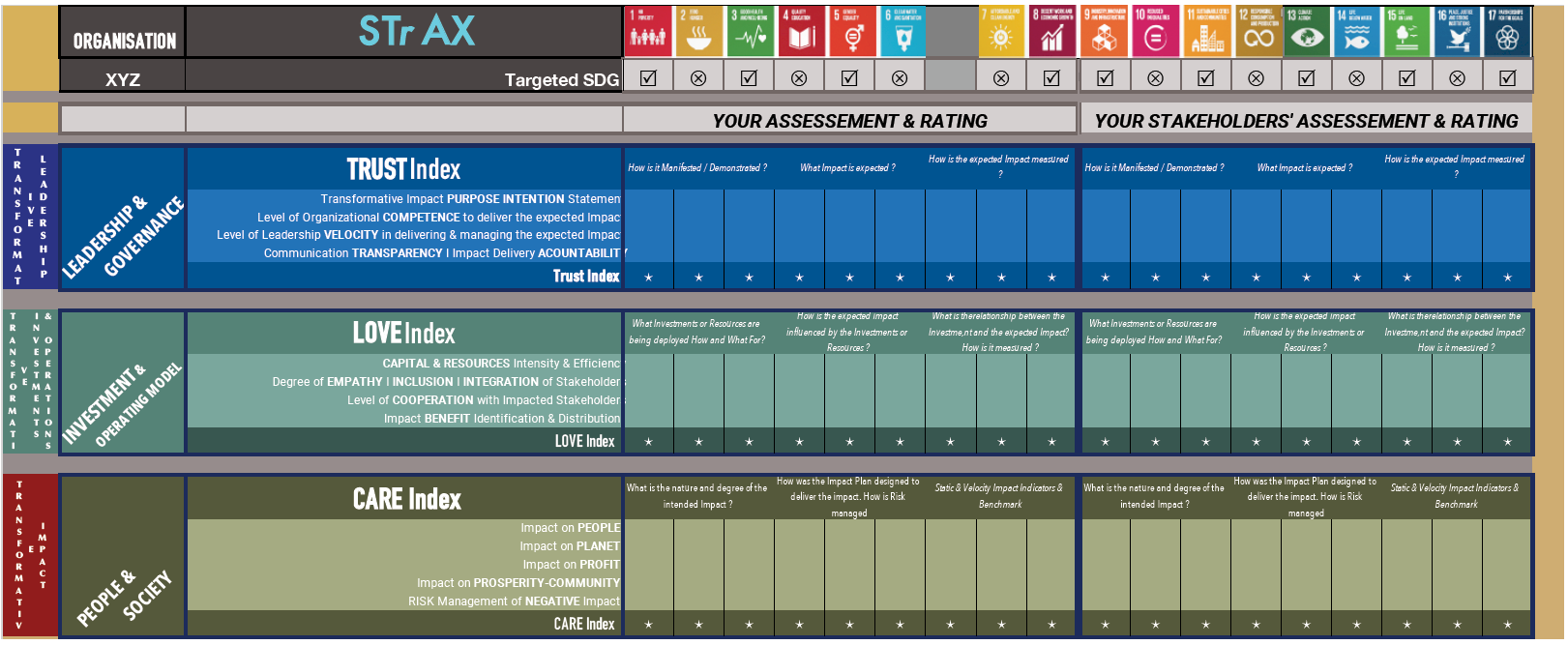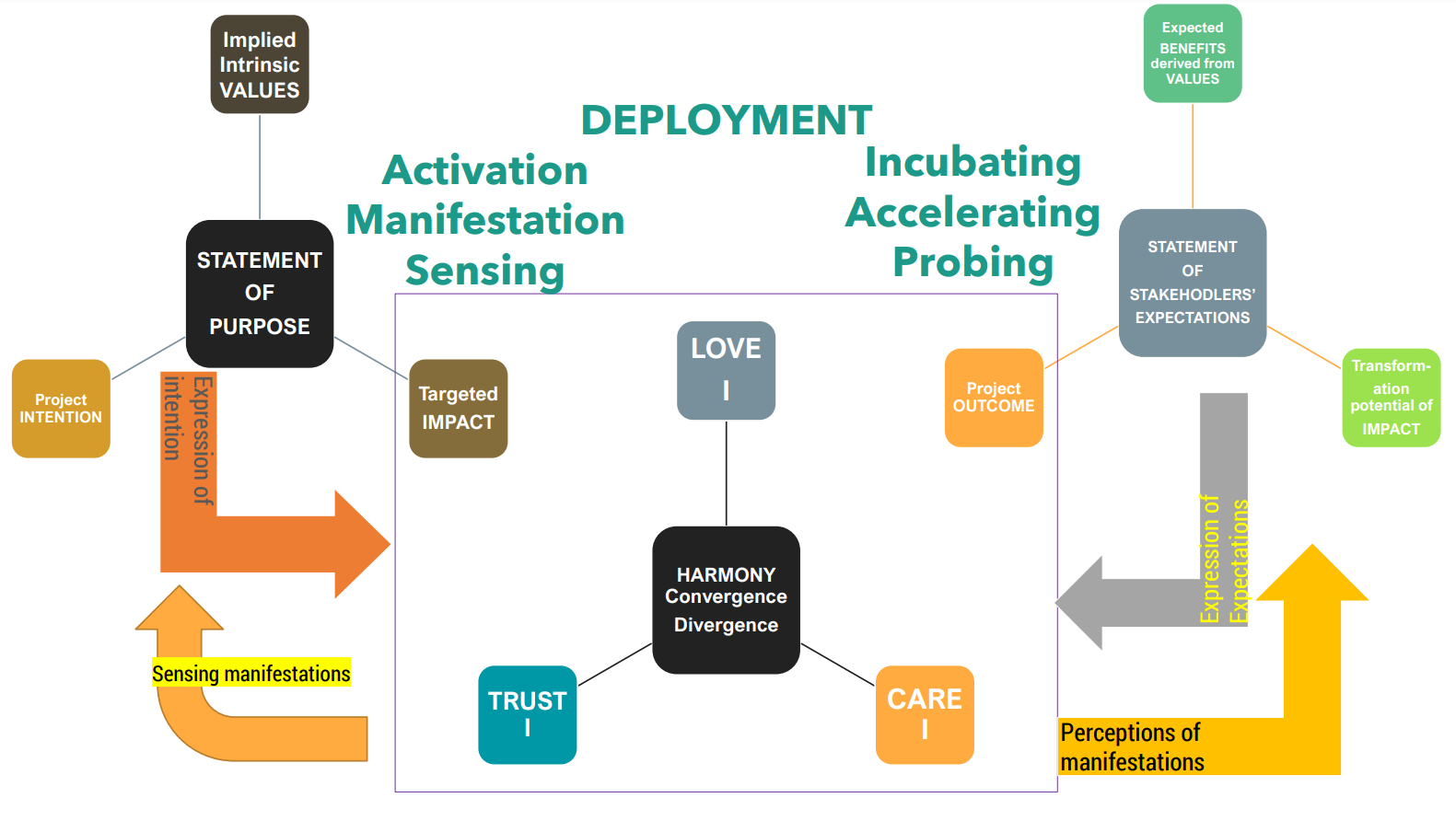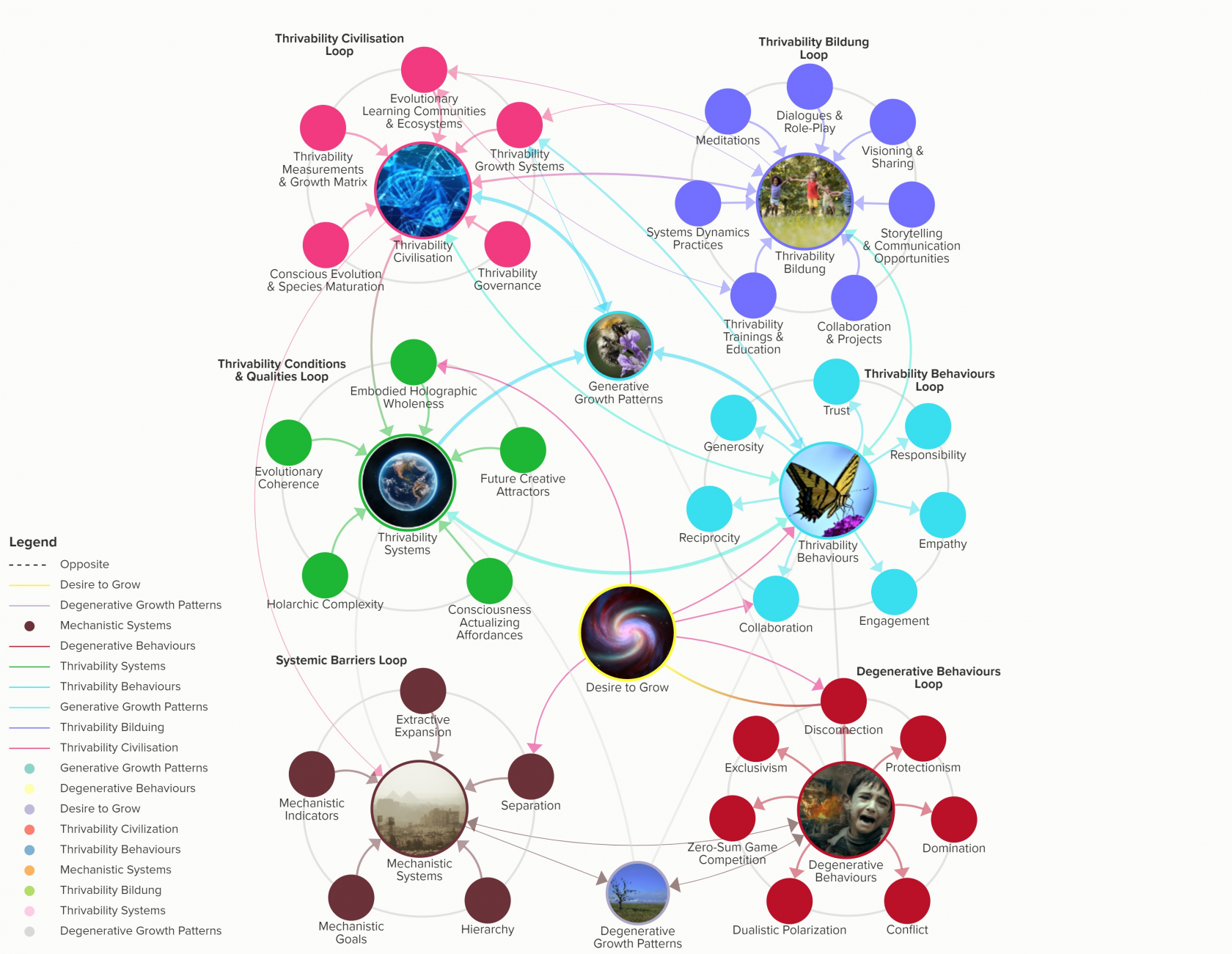Hypha and Seeds Impact Metrics
Approach
Overview
As Hypha (the organization) and Seeds (the movement) are slowly expanding their scopes, we need to build a framework to assess the impact we have on a wide range of initiatives for pilots on the ground and around the planet. While each initiative will have a different impact given the local context, we want to apply a common framework to measure key impact metrics, namely STrAX, a Sustainable Transformation Index developed by Aissa Azzouzi, the Activation Matrix, developed by Joachim Stroh and a System Map for Thrivability developed by Dr. Anneloes Smitsman. The result is a process (abstracted below) that can tell us how we are doing as our scopes are increasing from the individual-psychological (on the left) towards the organizational-cultural-communal, bioregional-governmental and - as an aggregate measure - the societal and the global (on the right).
It is important to note that we are working from both the individual (e.g. connecting to individuals starting to play the GPP game and become a resident) and the organizational (connecting with new alliance partners through the ambassador academy and network) as well as the bioregional-governmental (e.g. key players like Lisa and Franz working directly with government organizations in Costa Rica or Sweden). Having said that, the initiatives are very much focused on local "hot spots" (explained later) and pursue a complimentary strategy to rewarding broader audiences (e.g. all GPP holders) for participation in Seeds (e.g. via the Game of Seeds approach).
The map below is abstracted and the actual implementation will look different (see Rieki's Bioregion and Ecovillage deck for examples of a potential UI/UX).
Deployment Strategy
As Hypha is constantly developing new products for the global network and ecosystem, we need a solid deployment strategy to (1) ensure that the technology and blueprints can be adopted and adapted in a given local context and (2) to collect direct feedback from participants in the field to iterate and refine our solution sets. For this to happen, we introduce Accelerators and Incubators, a special kind of organization called "XOs" with a larger capacity, wider reach & access to pilot spaces on the ground. As part of the deployment strategy, these XOs must run assessments (surveys, interviews, etc) on a regular basis to check the pulse of the network (and as such level of coherence). Depicted below are both Hypha (Core Tech on the left), Accelerators and Incubators (using toolsets such as Org-in-a-Box, Marketplace-in-a-Box and Village-in-a-Box in the center) and the wider global network/ecosystem (on the right). Color coding can indicate the readiness on the ground across the different stakeholders, detailed in the Activation Matrix.
Activation Matrix
The purpose of the Activation Matrix is to ensure the full participation of key stakeholders on the ground across four different areas:
- Bioregional Activation (the goal is to protect & govern)
- Community Activation (the goal is to listen & learn)
- Knowledge Activation (the goal is to map & model)
- Alliance Activation (the goal is to build & sustain)
Each stakeholder will bring in unique perspectives, skills and expertise to provide for the "fertile soil" from which a potential solution can arise. Note that this approach is strictly "bottom-up", our task is to listen to and to amplify the signals that are already present on the ground. To tie the Activation Matrix to the Impact Metrics, note the "Hot Spots" depicted on the left side of the graphic. This is where the prioritization and the assessments are taking place, before, during and after the deployment of potential solutions on the ground. A color schema can assist in determining the current status of the activation (e.g. "all systems go" for the Community Activation below). To learn more about Activation Matrix (also called Glocal Impact Matrix), please watch this short video.
Implementation Mechanics
Sustainable Transformation Index
The Sustainable Transformation Index (STrAX) was developed by Aissa Azzouzi and includes an assessment matrix the collects a composite score for Trust, Love and Care.
Trust
- Transformative Impact PURPOSE INTENTION Statement
- Level of Organizational COMPETENCE to deliver the expected Impact
- Level of Leadership VELOCITY in delivering & managing the expected Impact
- Communication TRANSPARENCY I Impact Delivery ACOUNTABILITY
Love
- CAPITAL & RESOURCES Intensity & Efficiency
- Degree of EMPATHY I INCLUSION I INTEGRATION of Stakeholders
- Level of COOPERATION with Impacted Stakeholders
- Impact BENEFIT Identification & Distribution
Care
- Impact on PEOPLE
- Impact on PLANET
- Impact on PROFIT
- Impact on PROSPERITY-COMMUNITY
- RISK Management of NEGATIVE Impact
The assessment is applied (e.g. on a 5-star rating scale) across an array of key indicators (in this case the UN's 17 Sustainable Development Goals but it could be any other indicators, such as Kate Raworth's key indicators in the Doughnut Economics model or Seeds economic indicators, targets or objectives). The assessment and rating is done with both the probing organization and the impacted stakeholders and then compared to each other to see which if any discrepancies are becoming obvious. Larger mismatches indicate a higher degree of incoherence.
When starting a new pilot, a Statement of Purpose is be jointly developed ex-ante to clearly formulate and express the project's intention and implied intrinsic values. During this phase of the project launch, the team is beginning to manifest the impact and to document the outcome by consistently measuring the state of harmony and coherence through the Trust, Love, and Care index. The project is monitored ex-post with a Statement of Stakeholders Expectations that includes the expected derived values and the perceived transformation potential.
System Map for Transformational Change and Thrivability
The transformation potential can be further mapped onto a Complex Adaptive System (CAS) to distinguish sustainable, regenerative to thriveable processes. The System Maps that are presented here form part of a visual summary of the PhD research titled Into the Heart of Systems Change by Dr. Anneloes Smitsman, at ICIS, Maastricht University through EARTHwise Centre. The map provides a visual analysis of the systemic thrivability barriers and behaviors that emerge from (old world) mechanistic systems, compared to those from (new world) thrivability systems. For more information on the map, please see the Kumu chart.



